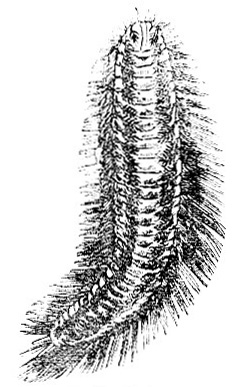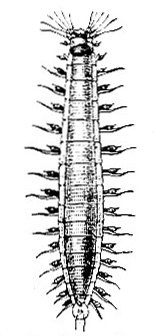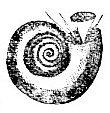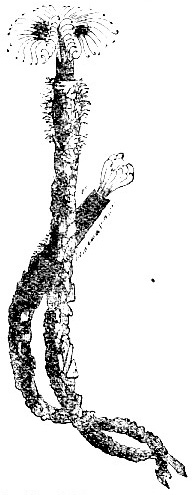1902 Encyclopedia > Annelida > I. Annelida Polychaeta (cont'd): Fossil Remains. Beauty, Form and Colour. A Note on Classification.
Annelida
(Part 6)
I. Annelida Polychaeta (cont'd)
Fossil Remains. Beauty, Form and Colour. A Note on Classification.
Tubicolar Polychaeta occur in various strata, from the Lower Silurian upwards and Serpulites even appear in the quarts of Durness. Many of the tracks and burrows referred to the group (Polychaeta) are involved in considerable doubt; but the Eunicites, Lumbriconereites, and Meringosoma, from the Solenhofen rocks, are satisfactory evidences of fossil forms. The arrangement of the apertures of Arenicola didyma, from the Longmynd, in pairs is peculiar.

Fig. 13 -- Chloeia
In regard to beauty of form and colour, complex structure and wonderful habits, the Polychaeta are not surpassed by any invertebrate class. The splendid bristles of the Aphroditidae, constantly glistening with all the hues of a permanent rainbow, the brilliant tints of the Phyllodocidae, Hesionidae, and Nereidae, and the gorgeous branchial plumes of the Terebellidae, Sabellidae, and Serpulidae, can only be compared with the most beautiful types of butterflies and birds.

Fig. 14 -- Hesione splendida, Sav. (After Savigny.)
The class Annelida has been divided into the sections Branchiata and Abranchiata, the former comprehending the Polychaeta, the latter the other groups; but this does not always hold good, since many Polychaeta have no branchiae. The latter, again, have been separated into the Dorsibranchs and Cephalobranchs, the former corresponding to the Maricola, Errantia, or Nereidae of others, the latters to the Tubicola or Sedentaria. Grube's divisions, Rapacia and Limivora, are based on the nature of their food.

Fig. 15 -- Spirorbis nautiloides, Lamarck.

Fig. 16 -- Sabella vesiculosa, Mont. (After Montagu.)
In the present state of the department it will suffice to indicate the following families (chiefly after Malmgren) under which the Annelida Polychaeta have been ranged, and to refer for further information to the Annelides of De Quatrefages, the Familien of Grube, the Chaetopoda of Ehlers, the Annelides Chetopodes of Claparede, the British Museum Catalogue by Johnston and Baird, and the various works of Kinberg and Malmgren: - EUPHROSYNIDAE, AMPHINOMIDAE (fig. 13), APHRODITIDAE, POLYNOIDAE, ACOETIDAE,SIGALIONIDAE, NEPHTHYDIDAE, PHYLLODOCIDAE, HESIONIDAE (fig. 14), ALCIOPIDAE, TOMOPTERIDAE (provisionally), SYLLIDAE, NEREIUDAE (fig. 1), STAUROCEPHALIDAE, LUMBRICONEREIDAE, EUNICIDAE (fig. 4), ONUPHIDIDAE (fig. 10), GONIADIDAE, GLYCERIDAE, ARICIIDAE, OPHELIIDAE, SCALIBREGMIDAE, TELETHYSIDAE (fig. 20), SPHAERODORIDAE, CHLORAEMIDAE, STERNASPIDAE, CHAETOPTERIDAE, SPIONIDAE (fig. 21), CIRRATULIDAE, CAPITELLIDAE, MALDANIDAE (AFIG. 9), AMMOCHARIDAE, HERMELLIDAE, AMPHICTENIDAE (figs. 11 and 12), AMPHARETIDAE, TEREBELLIDAE, SABELLIDAE (fig. 16), ERIOGRAPHIDAE, and SERPULIDAE (fig. 15).
Read the rest of this article:
Annelida - Table of Contents
|



